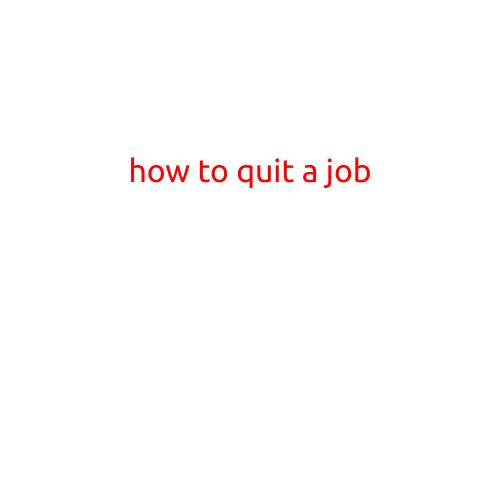
How to Quit a Job: A Step-by-Step Guide
Are you considering quitting your job? Whether it’s due to burnout, a lack of fulfillment, or a new opportunity, quitting a job can be a daunting and overwhelming experience. However, with a thoughtful and strategic approach, you can make the process less stressful and more effective. In this article, we’ll provide a step-by-step guide on how to quit a job, covering crucial topics like preparation, timing, and next steps.
Step 1: Prepare Yourself
Before quitting your job, take time to reflect on your reasons for leaving. Ask yourself:
- Is it due to a toxic work environment?
- Are you not challenged enough?
- Is it a matter of personal fulfillment?
- Do you have another job lined up?
Once you’ve identified your reasons, take a few days to journal, write down your thoughts, and process your emotions. This will help you clarify your motivations and feel more confident about your decision.
Step 2: Consider Your Timing
Timing is crucial when quitting a job. Avoid quitting during busy periods, such as:
- End-of-quarter or end-of-year deadlines
- Company restructuring or downsizing
- Peak sales or production seasons
Instead, aim for a slower period or consider giving your employer enough notice (usually 2 weeks) to find a replacement.
Step 3: Plan Your Exit Strategy
Before informing your employer of your decision, plan your exit strategy:
- Tie up loose ends: Complete any outstanding tasks, and ensure a smooth transition of responsibilities.
- Prepare documentation: Keep records of your work, including notes, files, and contact information.
- Update your LinkedIn profile and other professional contacts.
Step 4: Prepare for the Conversation
When speaking with your manager, be:
- Honest about your reasons for leaving (but not too critical)
- Grateful for the opportunities you’ve had
- Prepared to discuss your notice period and transitioning responsibilities
- Polite, professional, and respectful
Step 5: Follow Company Protocol
After the conversation, ensure you:
- Provide a formal resignation letter or email
- Schedule a meeting with HR to discuss benefits, severance, or other related matters
- Respect your employer’s expectations regarding notice period and job responsibilities
Step 6: Take Care of Practical Matters
Post-quit, focus on practicalities:
- Update your job title, company, and employment dates on social media
- Notify your network, including friends, family, and former colleagues
- Review your benefits, insurance, and any outstanding claims
- File for unemployment benefits, if eligible
Step 7: Focus on the Next Chapter
Use your transition period to:
- Update your resume, LinkedIn profile, and job search strategy
- Practice your interview skills and prepare for future job opportunities
- Reflect on your experience and identify lessons learned
- Plan and prepare for your next job, or consider taking time off to recharge
Conclusion
Quitting a job can be a challenging experience, but with the right approach, you can make the transition smoother and more effective. By following these steps, you’ll be better equipped to handle the process, maintain a positive professional reputation, and look forward to the next chapter in your career.
Remember, quitting a job is not the end of the world; it’s a natural part of professional growth and development. With a focused and prepared approach, you’ll emerge stronger, more resilient, and ready to take on new challenges.





